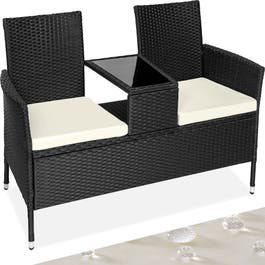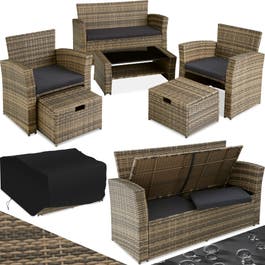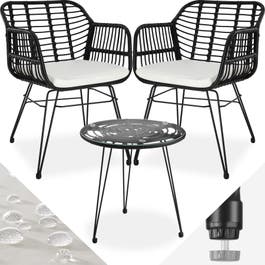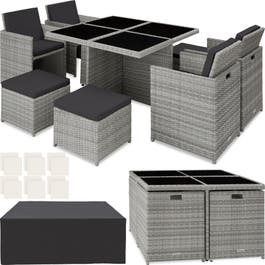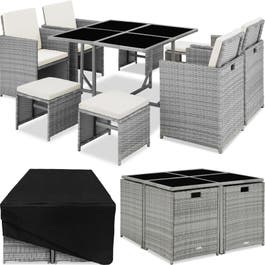Introduction to Rattan Dining Sets
When it comes to home and garden furnishings, rattan dining sets have emerged as a symbol of sophistication and comfort. These sets, known for their durability and stylish appearance, offer an inviting ambience for outdoor dining and leisure. Whether you're hosting a cosy family dinner or a larger gathering, a rattan dining set serves as the perfect backdrop for your events. Crafted from high-quality and weather-resistant polyrattan, these sets are designed to withstand the elements, ensuring longevity and ease of maintenance. The combination of robust steel or aluminium frames and chic design not only enhances your outdoor space but also promises an effortless assembly process, making it an ideal choice for any homeowner.
Why Choose a Rattan Set for Your Outdoor Space?
With a vast variety of outdoor furniture options available, you might wonder why rattan dining sets stand out. The answer lies in their unparalleled blend of functionality and aesthetic appeal. These sets are not only easy to clean, thanks to their water-repellent covers and detachable cushions, but also boast a stylish look that complements any garden or patio setting. The lightweight construction, coupled with its inviting look, offers both comfort and style without compromising on quality. Whether it’s a rattan bistro set for intimate settings or a more expansive arrangement with a rattan table and chairs, each piece is designed to enhance your outdoor dining experience.
How to Maintain Your Rattan Dining Set?
Maintaining the pristine condition of your rattan dining set is simpler than you might think. Given the weather-resistant properties of polyrattan and the robustness of the metal frame, these sets require minimal upkeep. To ensure longevity, regular cleaning with mild soap and water will suffice. The removable and water-resistant cushion covers add an extra layer of convenience, making them easy to clean and maintain. Additionally, storing the cushions in a dry place when not in use can extend their life and keep them looking new.
Choosing the Perfect Rattan Dining Set for Your Home
Selecting the right rattan dining set for your outdoor space involves considering both your functional needs and aesthetic preferences. Whether your heart is set on a cube rattan garden furniture set for its space-saving design or a rattan garden set for relaxed lounging, it's essential to choose pieces that reflect your lifestyle and complement your outdoor area. The key is to balance style with practicality, ensuring that your outdoor furniture not only looks inviting but also serves its purpose effectively. With a variety of designs available, from sleek and modern to more traditional looks, finding the perfect set to enhance your outdoor dining and leisure experiences has never been easier.
In conclusion, rattan dining sets represent the epitome of outdoor elegance, offering a harmonious blend of style, durability, and functionality. By choosing a rattan set for your garden or patio, you're not only investing in a piece of furniture but in an experience that takes your outdoor living to new heights. Remember to consider the ease of maintenance, quality of materials, and design when selecting your set to ensure that it meets your needs and enhances your outdoor space for years to come.
Benefits of Choosing Rattan Dining Sets from www.tectake.co.uk
- Exceptional Durability: Each rattan dining set is crafted from high-quality polyrattan, renowned for its durability and weather-resistance. This means your furniture will maintain their beauty and functionality season after season, providing long-lasting enjoyment without the need for constant maintenance.
- Elegant Design: Our rattan dining sets are designed with aesthetics in mind, featuring sleek lines and modern silhouettes that elevate the look of any outdoor space. Whether you prefer a classic or contemporary style, our extensive range ensures there’s something for every taste and setting.
- Comfort & Convenience: With ergonomically designed chairs and plush, water-repellent cushions, comfort is at the forefront of our rattan dining sets. The cushions come with removable covers for easy washing, ensuring your outdoor dining area remains fresh and inviting.
- Easy Assembly & Maintenance: We understand that time is precious. Our rattan dining sets are designed for easy assembly, allowing you to enjoy your new outdoor dining space in no time. Maintenance is equally straightforward with simple cleaning methods, keeping your set looking as good as new.
- Versatile Use: From intimate rattan bistro sets, perfect for cosy corners, to larger rattan garden dining sets, ideal for entertaining guests, our range offers versatility to fit any outdoor space or occasion. Whether it's for enjoying a quiet morning coffee or hosting a lively dinner with friends, our rattan dining sets create the perfect setting for memorable moments.
- Sustainable Choice: Polyrattan is an eco-friendly option, offering the look and feel of natural rattan. By choosing our polyrattan dining sets, you’re making a responsible and sustainable choice.
- Competitive Pricing: At www.tectake.co.uk, we believe in offering exceptional value. Our rattan dining sets offer affordable prices without compromising on quality or design, ensuring you receive the best value.
- Customer Satisfaction Guarantee: Dedicated to delivering the best service, customer satisfaction is a top priority of ours. Should you have any concerns or need assistance, our dedicated customer service team is ready to ensure your shopping experience is seamless and satisfying.

